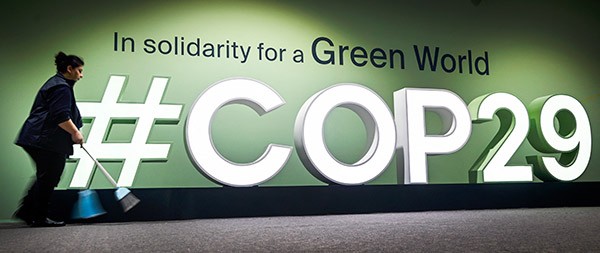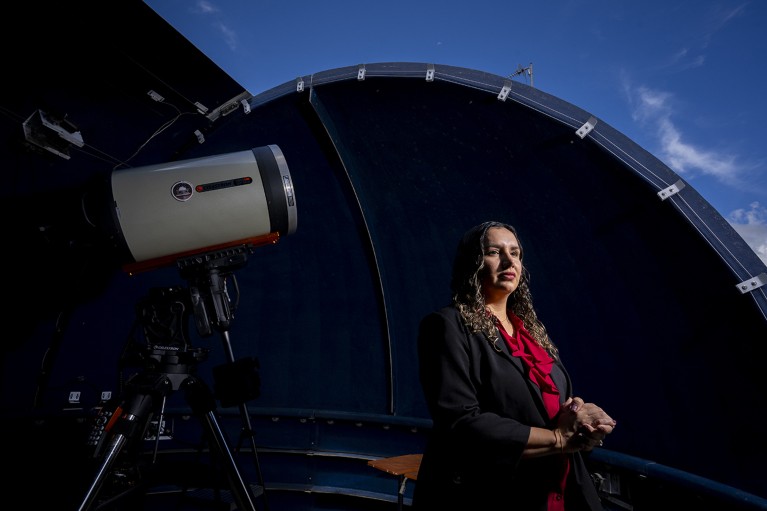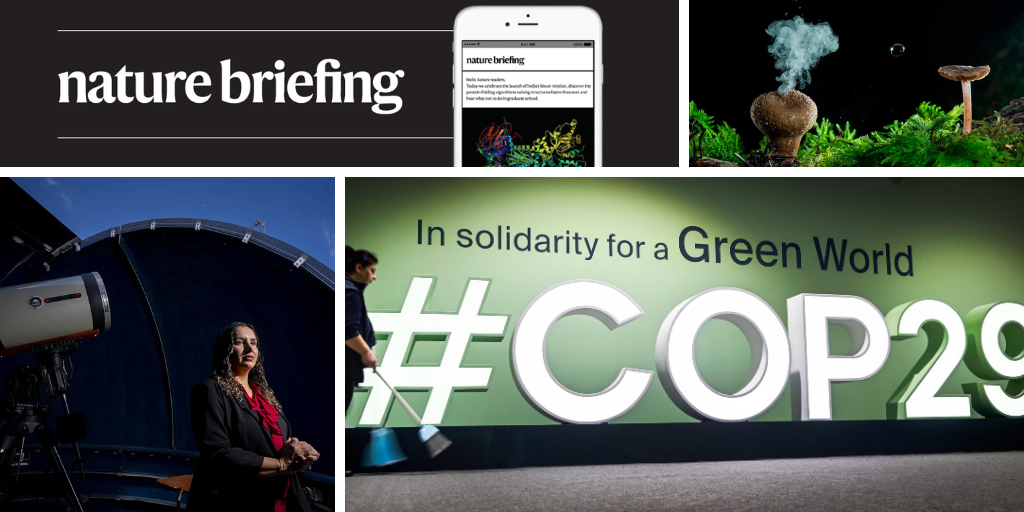Hello Nature readers, would you like to get this Briefing in your inbox free every day? Sign up here.

Alexander Nemenov/AFP via Getty
“I am half agony, half hope.” Jane Austen’s words come to mind as delegates recover from a marathon negotiation that brought to a close the 29th United Nation’s annual climate conference (COP29).
Hope:
• Rich nations agreed to raise US$300 billion per year in cash and loans from 2035 to help poorer countries to nix fossil fuels and adapt to a warming world. The obligation is seen as both moral — wealthy countries created most emissions and got rich doing so, whereas poor countries are most vulnerable to their effects — and pragmatic: paying for decarbonization will prevent a much bigger bill if climate change is left to run rampant. (The Guardian | 6 min read)
• The deal is an increase on the previous climate finance target, set in 2009 at COP15, of $100 billion per year — ostensibly by 2020 but not achieved until two years later. (Nature | 10 min read, from 2021)
• The agreement also calls on countries to work together to balloon this number to $1.3 trillion, most likely with additional private funding.
• An effort led by Saudi Arabia failed in its bid to backtrack from last year’s breakthrough pledge to “transition away from fossil fuels”. The issue was swept under the carpet until next year. (Middle East Eye | 1 min read)
• After years of deadlock, COP29 finalized a framework for a global market in carbon trading — which will hopefully provide a key mechanism for developing countries to raise climate finance, though there are major concerns about the integrity of such schemes. (Financial Times | 4 min read)
Agony:
•Two countries with climate sceptics at the helm (or soon to be), the United States and Argentina, have pledged to leave the Paris Climate Agreement. (Deutsche Welle | 5 min read)
• Leading voices including former Secretary General of the United Nations Ban Ki-moon and climate scientist Johan Rockström say the COP climate talks are no longer fit for purpose. “This lethargic progress is at odds with climate science and real-world climate damage and risks,” they wrote in 2023. “We need a shift from negotiation to implementation,” they reiterated this year. (The Club of Rome open letter | 7 min read)
• Representatives of many of the poorer countries at the heart of this year’s agreement say it is woefully insufficient and was pushed through by the big players. “Developed nations always throw text at us at the last minute, shove it down our throat, and then, for the sake of multilateralism, we always have to accept it,” says Juan Carlos Monterrey Gómez, Panama’s special representative for climate change. (The Guardian | 6 min read)
• COP29 president Mukhtar Babayev, Azerbaijan’s ecology and natural resources minister, who faced criticism for his career at the country’s state-owned oil company, among other things, argues that Western nations stood in the way of a better deal. “The Chinese were willing to offer more if others did so too (but the others didn’t),” he writes. (The Guardian | 5 min read)
Read more: CarbonBrief offers an exhaustive summary of everything achieved at COP29 — and everything not (70 min read)
Keep abreast of climate news in our free weekly newsletter, Nature Briefing: Anthropocene.
Features & opinion

Fungi can propel their spores high into the air.Credit: Stephane Vitzthum/Biosphoto/Alamy
In his new book, Close Encounters of the Fungal Kind, Richard Fortey “does mycology a great service by transcending the strange with science”, writes biologist Nicholas Money. “The book is full of evocative descriptions born from deep personal experience”, says Money, as Fortey takes a break from his usual field of palaeontology to share his love of fungi and take the reader on a guided tour of the world’s mushrooms, “from the hallucinogenic to the hideous”.
Heat exposure raises the risks of preterm birth, stillbirths, congenital anomalies and obstetric complications. In the largest systematic review of its kind, researchers analysed 198 studies across 66, mostly high-income, countries. For every 1 ℃ increase in heat exposure, there was a 4% increase in the risk of a child being born prematurely — which is one of the leading causes of infant death or long-term disability. During a heatwave, the chance of preterm birth increased by 26%. “Protecting the health of pregnant women and newborns must become a priority in our response to climate change,” said physician-scientist and review co-author Darshnika Lakhoo in a statement.
When intensive-care physician Jean Pierre Sibomana was faced with two young patients displaying signs of haemorrhagic fever, he had to make an incredibly difficult choice: to diagnose Rwanda’s first confirmed outbreak of Marburg virus disease. “I knew… that this diagnosis could have profound political and economic implications,” he writes in a powerful first-hand account of the experience. He did what he had to do: isolated from outsiders, he and his colleagues battled a disease with an expected fatality rate of nearly 90%. Two doctors and many nurses died. “We cared for both patients and colleagues with broken hearts, and we mourned together every day for the souls that were leaving us,” writes Sibomana.
The New England Journal of Medicine | 7 min read
Where I work

Desireé Cotto-Figueroa is an astronomer and coordinator of the Astronomical Observatory at the University of Puerto Rico at Humacao.Credit: A. Enriqueta Valentín Concepción for Nature
Astronomer Desireé Cotto-Figueora is part of NASA’s Near-Earth Object Surveyor mission, which aims to spot big near-Earth asteroids to identify potential hazards. “In high school, I started an astronomy club and visited nearby observatories, including the one I work at now,” she says. “I don’t think that high-school girl would ever have imagined that one day she’d be working on a NASA mission.”
On Friday, Leif Penguinson was basking in the lush green moss of Satasarvinen (“Hundred Horns Hill”) on Muuratsalo Island, Finland. Did you find the penguin? When you’re ready, here’s the answer.
Thanks for reading,
Flora Graham, senior editor, Nature Briefing
With contributions by Jacob Smith
Want more? Sign up to our other free Nature Briefing newsletters:
• Nature Briefing: Careers — insights, advice and award-winning journalism to help you optimize your working life
• Nature Briefing: Microbiology — the most abundant living entities on our planet — microorganisms — and the role they play in health, the environment and food systems
• Nature Briefing: Anthropocene — climate change, biodiversity, sustainability and geoengineering
• Nature Briefing: AI & Robotics — 100% written by humans, of course
• Nature Briefing: Cancer — a weekly newsletter written with cancer researchers in mind
• Nature Briefing: Translational Research — covers biotechnology, drug discovery and pharma


